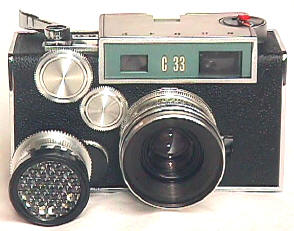
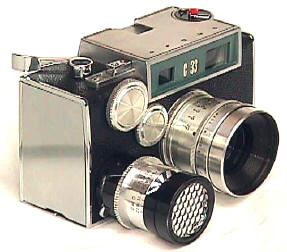
Home Camera Articles FOR SALE Orders I Buy / Wants Repairs Books Adapters
|


Argus C-33 aka Brick 33 aka Walter Mitty
the brick that wanted to be a Leica
if you liked "The Little Train that Could," You'll love this one
It was 1956. Eisenhower had just been re-elected. America was confident. With that overwhelming confidence, imagine the original Volkswagen Beetle trying to be a Rolls Royce, or a BIC pen trying to be a Mont Blanc, or a paint by numbers trying to be a Rembrandt. Now you are getting to understand the Argus C-33, Walter Mitty reborn in a camera.
You see, the Argus C-33 is the brick that wanted to be the Leica. That's right, I love 'em. They make me laugh. In fact, the C-33 is by far my favorite Argus. I write that seriously....but with a smile on my face. Today the C-33 is not that common, but a complete C-33 outfit is difficult to find. That's right camera fans, brace yourself for what is sure to be a bad dose of camera lust.
To understand the C-33, you have to understand the C-3 -- otherwise it doesn't make any sense...or almost make sense anyway. Starting in 1936, the former radio manufacturer found the big bucks in the Bakelite 35mm camera field. I've read that MILLIONS of C-3's were sold, proving buyer's perceptions make the sale. Come to think of it, what isn't like that? Nicknamed named "the Brick" for obvious reasons, the C-3 was THE 35MM CAMERA for many Americans, for not so obvious reasons, but that is another story. The C-33 is a C-3 with attitude and "Pro" features.
After all, if you had sold a couple of million C-3's, why not add features and sell even more? Why shouldn't it work? Well, since you asked, because the C3 had already stretched the limits of its market audience beyond reason. By adding Leica like features, the C33 unfortunately went on to the next level of photo awareness, only to quickly sink like the proverbial bad Hollywood remake into the bottomless black abyss of a Hollywood executive's nonexistent conscious . Damn. Maybe I am a writer, well maybe not. hmm.
Imagine a C-3 with nifty pro improvements: Lever Film Advance, Lever Film Rewind, four interchangeable bayonet lenses, auxiliary viewfinder and even coupled exposure meter!! Yep, you can be assured the Argus marketing department dreamed up a real honey of a camera. Not to be outdone, the Argus styling department added wonderful bits of style, most of it questionable. Nevertheless, the C33 was the undoubtedly best of the Argus brick series. Good Brick.
Aesthetically the C-33 sports a CHROME shutter release, advance lever, side panels, top plate, back edge plate, focusing wheels, shutter speed dial, back hinges, and interchangeable lenses. For the photographically uninitiated, all these shiny features combined to the apparent heights of assumed perceived photographic expertise and precision. In other words, the Argus styling department worked overtime to give it the right IMAGE to increase sales. It had to look the part, and did. Of course there was that strange brick shape, but was an advantage, since the C-33 was intended to build upon the wet photographic dreams of those millions of C-3 owners. It was sound marketing, great marketing. The only problem was that most C-3 owners were already in far over their heads photographically. The intended immense waiting market of C-3 owners lustfully wanting an improved C-3 didn't exist, they had a hard enough time already trying to figure out the mysteries of the C-3. I've been unable to confirm the persistent rumor of the C-33 marketing analysis team going on to make automobile history with the C-33's kindred spirit on wheels, the Edsel.
It's difficult to accurately describe the C-33. Phrases like amazing, unique, bewildering, and unbelievable come to mind--to my mind at least. Start with a brick, add lots of chrome, gears, gadgets and levers, and you might be starting to get the right idea. OK, Let's get the basics characteristics out of the way:
C-33 Claims to Fame
1) An excellent bright viewfinder / rangefinder window. The image and RF patch is much larger than the screw mount Leicas. This really is a VERY nice finder. Photographically speaking, this feature will hold its own against tougher competition than any other part of the C-33. Of course, if that 33 has been in the closet for the last four decades, you will have to have the finder cleaned to see it at its best.
2) Excellent and easy to use bayonet lens mount, by far the best designed and easiest to use Argus interchangeable lens mount.
3) Unforgettable styling. True to Argus tradition, the C-33 LOOKS like a lot more camera than it is. Speculation that the C-33 is a BORG design has not been confirmed. Perhaps the secret will be revealed when Star Trek Voyager and 7 of 9 return to Earth.
3) Large blunt sides, making it great for the proverbial "blunt instrument" in murder mysteries
4) A secret undocumented poison pen spy device, cleverly disguised as a film rewind lever. Place poison dart frog poison on the so called "rewind lever," and insert into the opposing agent's body with a quick wrist action. Death arrives on swift wings within minutes. However, don't forget to be very careful the next time you rewind film. The CIA lost a lot of agents like that.
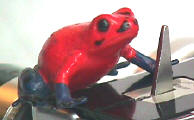
Rare CIA photograph obtained through the Freedom of Entertainment Act, showing Guatemalan Poison Dart Frog Dendrobates Pumilo secreting deadly toxins on C33 rewind lever, (aka Stealth Camera Dagger Mark 1).
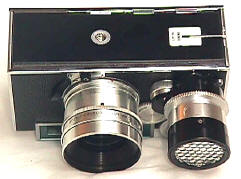
Using the Brick 33
Perhaps the best feature is the unusually large and bright (for this genre of camera) combined rangefinder and viewfinder window. No, there is no parallax correction or correction markings, but at least it's an excellent image and large RF spot, so long as the finder is clean. In fact, it is superior to the Leica Screw mount rangefinder and viewfinders, a rather surprising fact.
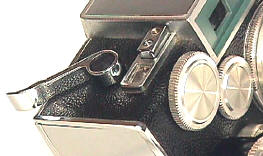 The advance lever and shutter release are both unusually large and smooth for
a camera in this price range, though the advance is not ratcheted. The C-33 offers
easy one handed operation while doing your Peter Stackpole imitation, shooting
that award winning picture essay from the heights of the Golden Gate Bridge.
Grasp the bridge with your left hand, while holding the camera with the right. You
will be able to advance the film with your thumb, and focus using your index finger on the
front mounted focusing wheel. If you jiggle a bit in the wind and the
camera drops, like a....brick....remember not to use the left hand to catch the brick with
your Willie Mays look alike catch. Unlike the 1932 Zeiss Contax
which I suspect the Argus C series was styled after, the C-33 lens construction
makes it impossible to focus by turning the lens--you must turn that focusing wheel
or else!!
The advance lever and shutter release are both unusually large and smooth for
a camera in this price range, though the advance is not ratcheted. The C-33 offers
easy one handed operation while doing your Peter Stackpole imitation, shooting
that award winning picture essay from the heights of the Golden Gate Bridge.
Grasp the bridge with your left hand, while holding the camera with the right. You
will be able to advance the film with your thumb, and focus using your index finger on the
front mounted focusing wheel. If you jiggle a bit in the wind and the
camera drops, like a....brick....remember not to use the left hand to catch the brick with
your Willie Mays look alike catch. Unlike the 1932 Zeiss Contax
which I suspect the Argus C series was styled after, the C-33 lens construction
makes it impossible to focus by turning the lens--you must turn that focusing wheel
or else!!
So, to this point in time we have an excellent advance, shutter release, and combined rangefinder-viewfinder window, plus interchangeable lenses. And it looked like an advanced camera with lots of chrome. All of these added up to a powerful sales presentation at the local camera shop.
The shutter speed dial is located on the front of the camera, with speeds from 1 sec to 1/300th. The f/stops are controlled on the lens aperture ring. Of course 1/300th is not an especially high shutter speed, but if you knew there were higher shutter speeds, you had no business buying the C-33 new anyway.
Film Loading: Pushing up on a
chrome latch on the back open up the back. The entire back is hinged at the lower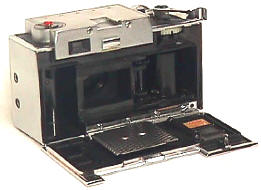 edge, opening to
reveal easy access to the film chamber. The advance spool is very thick, with
a tooth to catch the film leader. The film counter has to be manually set at either
24 or 36 exposures, with the back open. If you set it on any other numbers, the back
will not close. The film counter counts down, showing the number of frames left on
the roll.
edge, opening to
reveal easy access to the film chamber. The advance spool is very thick, with
a tooth to catch the film leader. The film counter has to be manually set at either
24 or 36 exposures, with the back open. If you set it on any other numbers, the back
will not close. The film counter counts down, showing the number of frames left on
the roll.
To rewind the film, you must first pull out the bottom located film rewind lever, push the plastic red tip of the rewind lever, pull the plastic rewind lever out, and rewind the film. Make sure you reset the film counter to 24 or 36, or the back will not close. The retractable plastic rewind lever is very large, but of dubious strength. Be careful, or you may break it off.
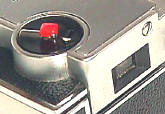
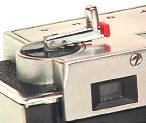
If you want to use the Brick 33 today, 40 years after it was made and 35 years after it was sat in that proverbial closet, do yourself a favor and spend a few bucks to bring it back to original specs. The viewfinder is almost certainly fogged up over the years. The lenses themselves probably need a professional cleaning. The shutter and focusing mechanism (on the camera and in the lenses) probably need to be re-lubed. This is not an indictment against the Brick, you would have to do much of the same things on a closet Leica too, but probably not on that Nikon!! But of course it's a relatively simple camera, so you might want to try cleaning it yourself. My friend Alex is like that. He also has about a dozen cameras he can't get back together again, but he always claims the next one will work out just fine.
C-33 Lenses:
All C-33 lenses have rangefinder coupling, lightweight aluminum barrels, click stops, factory lens coating, and focus to just under 3 feet. All have depth of field scales. All are professional looking shiny chrome. Shown, left to right, are the 100/4.5, 50/2.8 and 35/4.5, along with their respective shades. All lenses use a double non-rotating helical mount, so the f/stops and depth of field scales are always visible from above. The 35 and 50 leather lens cases hold the lenses with lens shade attached.
All C-33 Lenses conveniently used the same Series 5 filter size, held in place by the screw in shade.
35/4.5 Argus Coated Cintar, a German Steinheil four element lens, click stops f/4.5 to f/22.
50/3.5 Cintar, this seems to be the rarer of the two normals, presumably a 3 element lens.
50/2.8 Cintar made in the USA with click stops from f/2.8 to f/22, presumably a 3 element lens.
100//4.5 Argus Coated Cintar, a German four element lens made by Steinheil, click stops from f/4.5 to f/22. If your Brick 33 needs lubrication from sitting all of those years, this lens can become a real chore to focus, due to its larger size and greater strain on the gear train.
35-50-100 Parallax corrected "Zoom"
Viewfinder, with fitted case. This is a very usable, easy to see
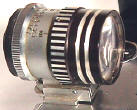 large
field finder. It shows a bright image, which is masked off to the appropriate size
as you turn the barrel to select longer focal length lenses. Foreshadowing the
future demise of Argus cameras, in a marketplace soon to be dominated by Japanese
products, this excellent viewfinder was the only part of the C-33 outfit "MADE IN
JAPAN." There were four wide to tele viewfinders for the Argus C-33, C44 and
C44R. This is my personal favorite with what I consider the best image.
Note the auxiliary wide to tele finders were the ONLY means to provide parallax
compensation, since no Argus camera body had built in parallax compensation.
large
field finder. It shows a bright image, which is masked off to the appropriate size
as you turn the barrel to select longer focal length lenses. Foreshadowing the
future demise of Argus cameras, in a marketplace soon to be dominated by Japanese
products, this excellent viewfinder was the only part of the C-33 outfit "MADE IN
JAPAN." There were four wide to tele viewfinders for the Argus C-33, C44 and
C44R. This is my personal favorite with what I consider the best image.
Note the auxiliary wide to tele finders were the ONLY means to provide parallax
compensation, since no Argus camera body had built in parallax compensation.
C-33 Lens Mount
The lens mount a C-33 highlight, representing the pentacle of Argus interchangeable lens mounts. Unfortunately no other Argus shared the excellent C-33 mount, ehh relatively excellent mount, ehh the pretty good for an Argus lens mount.
The lens release is the black plastic rectangular button next to the lens. Push it up and turn the lens counter clockwise to remove the lens in an quick easy 45 degree twist. That funny looking blue metallic thing behind the lens is the leaf shutter. Don't push your fingers through it if you want to take pictures any time soon.
To mount the lenses 1) align the red dots on the camera body and lens mount by rotating rangefinder wheel 2) Align red dots on lens mount and lens helical 3) insert lens and turn clockwise to lock it. While this system is not as easy as modern cameras, it is very easy and quick compared to any other Argus rangefinder in the lens changing race. The Guess modified C4 takes 2nd place. The C-44 and C-44R take a very distant third. If you wish to stretch the point and consider the C-3 an interchangeable lens rangefinder, the C-3 finishes a spectacularly poor fourth, well back over the horizon in this ease of lens changing race.

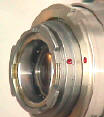
X sync: yeah, right
Just below the lens mount you will see a prominent switch labeled "X" and "M," but no PC connection or hot shoe. Initially I thought it was great to be able to shoot electronic flash with my mighty C-33. Alas, the truth was in the instruction book. For reasons which are totally beyond me, while the rest of the camera industry was using "X" to indicate electronic flash and "M" to indicate flash bulbs, Argus decided they should both indicate flash bulbs, but different KINDS of flashbulbs. Hmm. Wait a minute. Maybe it was just a marketing design to gain an extra edge. Anyway, with the C-33, the X setting is for those ever popular and easy to get Sylvania M25 or M2 flashbulbs, to a 1/30th. The M setting is for the big guys, the Sylvania Press 25 or Press M5 bulbs, at speeds all the way to 1/300th. If you have a stash of flash bulbs and want to bring the flash gun back to life, it uses a 22.5 volt Ray-o-Vac 221, Eveready 505, Burgess Y15, Bright Star 22P, or proverbial equivalent.
Naturally of course, there was the special Argus handy folding flash unit -- also usable on Brick siblings, the C-3 and C-3 Matchmatic. It's a nice compact design that folds into a little box when not in use. You then open it up and unfold the flash reflector, attaching the flash unit to the camera much like a rather convenient handle. At least it would have been a convenient handle, if the designers used a locking device. Instead, the flash unit merely uses two prongs to press fit into the camera body. While seemingly secure, it secretly awaits for the photographer to grip the handle for a little too long, only to self detach the camera body on the hardest surface available. This might seem a bad thing, but it increased camera sales.
A Meter ON the camera? What Next?
This little gem was usable on four different Arguses, Argi, ehhh Argus, the C-33, C-4R, C-44, and C-44R. It's the famous shutter coupled selenium exposure meter which fits over the shutter speed dial.
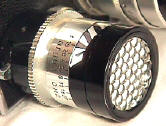 To
mount it, you first have to remove the cover of the shutter speed dial, noting the
set shutter speed. Then you rotate exposure meter coupling until it is set just like
the body, to ensure proper coupling. Then you carefully attach the
exposure meter shaft into the shutter speed dial cavity. Lock down the meter
with the locking lever, visible in the far left of the photo.
To
mount it, you first have to remove the cover of the shutter speed dial, noting the
set shutter speed. Then you rotate exposure meter coupling until it is set just like
the body, to ensure proper coupling. Then you carefully attach the
exposure meter shaft into the shutter speed dial cavity. Lock down the meter
with the locking lever, visible in the far left of the photo.
OK, so the camera and the exposure meter are now one. All you have to do now is select whatever shutter speed you desire, and read the meter needle which the indicates the suggested f/stop. Then all you have to do is transfer that f/stop to the lens. You see, the meter is coupled to the shutter speeds, not the f/stops.
For those of you not familiar with Selenium meters, they were the standard light meter from the middle 1930's to the coming of battery powered CDS cells in the late 1950's. Light striking the selenium cell generates electricity, which in turn moves the needle to the indicated light reading. Selenium meters never need batteries, and have a broad light sensitivity -- much like the human eye. The biggest disadvantage is selenium cells are not sensitive enough for low light levels. Eventually after 30 plus years, the selenium cells eventually wear out and are no longer light sensitive. If you have a selenium cell, keep it covered when not in use to prolong its life. In today's transistorized world, it's very difficult to find replacement selenium cells.
The meter seems to have a large angle of acceptance, probably 60-70 degrees. The marked ASA range is a rather surprising 2.5 to 1250. Ever mindful for details, even a zero needle adjustment is provided. It's that little screw on the side of the barrel. Cover the front of the cell, and turn the screw until it screams zero.
C-33 Serial #'s and Production
Exact production presently unknown, but I can say with certainty that it is a relatively hard to find Argus. The serial #'s are essentially hidden, in very hard to see small figures on the bottom plate, to the right and below the tripod socket as you hold the camera upside down. The Argus Company Home Page lists the starting serial # as 151910100101. Yet, I own # 1511114099. I have also seen #'s 1519305799 and # 1519306551. After careful analysis of all the possibilities, the influence of the moon and high tide, and a carefully re-reading of the Lost Sea Scrolls, I have come to the tentative conclusion that at least three C-33's were manufactured. More research needs to be done on this subject.
Argus Leather
Argus used unusually high grade "FULL GRAIN SADDLE LEATHER." They weren't kidding, it is high grade Saddle leather. The Argus light tan leather looks like it belongs on a horse, some cases are even marked "California Saddle Leather. "
 Why you ask? Argus aimed to achieve the right perception in the
eye of the buyer. By clothing their middle of the road camera with the highest
quality leather goods, cowboy style at that, Argus instantly made their camera look even
better to the American public. Remember, the 1950's were the Golden Age of the
Hollywood Cowboy--John Wayne was the number one box office attraction. Argus
knew their American customer in the 1950's, and the Argus marketing department did a great
job to rope them on in. You see it wasn't just advertising. The product
was made to fit what the public wanted...what a great idea.
Why you ask? Argus aimed to achieve the right perception in the
eye of the buyer. By clothing their middle of the road camera with the highest
quality leather goods, cowboy style at that, Argus instantly made their camera look even
better to the American public. Remember, the 1950's were the Golden Age of the
Hollywood Cowboy--John Wayne was the number one box office attraction. Argus
knew their American customer in the 1950's, and the Argus marketing department did a great
job to rope them on in. You see it wasn't just advertising. The product
was made to fit what the public wanted...what a great idea.
Size Matters
Complete with 50/2.8 lens and selenium meter attached, the Brick 33 weighs in at a robust and manly 2 lbs, 2 oz. In contrast, the lightly constructed Leica Titanium M6 with 50/2 Summicron only weighs in at a anemic paltry 1 lb. 7oz. Obviously this proves the C-33 is the better constructed and more professional of the two cameras. Besides, the Brick 33 has a lot more chrome!
The Argus Lifetime Marketing Plan, eh Guarantee
"Your Argus was manufactured, inspected, and tested by skilled craftsmen. It is automatically guaranteed when purchased to be free of defects in workmanship or material during its lifetime. If any service is necessary because of imperfections in material or workmanship, your Argus will be factory serviced without charge.
Argus equipment which has been damaged, mishandled, or worn from extensive use will be factory service at established rates. Equipment purchased as used or rebuilt is not covered by this guarantee."
This really is an excellent warranty, but of course it was really a marketing tool disguised as a guarantee, to inspire confidence in Argus cameras and increase sales. It worked, millions of times!
Brick? Why did they call it a Brick?
Don't just take pictures! Become an image, make an unforgettable impression with your C-33!
To put it another way, show up shooting the Brick 33 and the other photographers will never look at you quite the same again.
Ah yes, the call of the Argonuts.
For more info Visit: the Argus Collector's site and the Argus Discussion Forum
Home Camera Articles FOR SALE Orders I Buy / Wants Repairs Books Adapters
Revised: January 31, 2016 . Copyright � 1998-2002 Stephen Gandy. All rights reserved. This means you may NOT copy and re-use the text or the pictures in ANY other internet or printed publication of ANY kind. Information in this document is subject to change without notice. Other products and companies referred to herein are trademarks or registered trademarks of their respective companies or mark holders.